On June 25 the State of Michigan reported 353 new COVID-19 cases, which is the highest number of single day cases since May. While the recent new case number data remains under the peak number of new daily cases reported in April, when we were seeing numbers in the thousands, the State of Michigan is showing signs of an uptick.
On June 25, the State of Michigan reported a total of 62,306 cases, an increase of 353 cases from the day prior. The daily total was equivalent to 624 cases per 100,000 people (Chart 4). Of those 353 cases, 144 were documented in Southeastern Michigan. In total, 41 percent of the new COVID cases were in Southeastern Michigan, meaning case numbers are increasing at a higher rate outside of the region than locally. In Chart 1 we show that the State total for the number of COVID cases on June 22 was 61,706–a five-day rolling average. The five-day rolling average for the total number of COVID cases (Chart 1) reflects a smoother curve and adjusts for fluctuations in testing and/or the quality of reporting or failure to report. A look at Chart 1 further reflects the recent uptick in new daily cases, showing a less flattened curve in the last few days.
Chart 2 shows that, based on the five-day rolling averages, the growth of new COVID cases in Southeastern Michigan continues to increase but at a slower rate than previously, and at a slower rate than that of the entire State. On June 23 the number of cases in Detroit reached 11,432, the highest in the region, and Wayne County reported the second highest number of cases at 10,006. On June 22, the five-day rolling average for the number of COVID cases in Oakland County was 8,692, and Macomb County reported 7,004.
The City of Detroit had 1,708 COVID cases per 100,000 people as of June 25, an increase from 1,699 on June 24 (Chart 3). This is based upon a reported increase of 24 new COVID cases between June 24 and June 25, bringing the total number of COVID cases in Detroit to 11,492. Wayne County reported 936 cases per 100,000 people, and Oakland County had 694 cases per 100,000 people. These per capita rates were based upon 10,081 total cases for Wayne and for 8,733 Oakland. Macomb County reported 806 cases per 100,000 people, which is based upon 7,047 cases.
The daily data highlighted in these posts is from Michigan.gov/coronavirus, where data is updated daily at 3 p.m. Historical data were supplied from covidtracking.com, which republishes COVID data from the State. Additionally, the case totals do not reflect the number of people who have recovered, just those who have been infected. In early June the State changed how it reports its data on the website, making data more accurate in the long-term but more complicated to track as well. The State regularly updates older data and as we continue to publish regular updates on COVID the State’s changes to past data many not always be reflected in our posts. The data published in new posts is accurate for the day we received it on though.
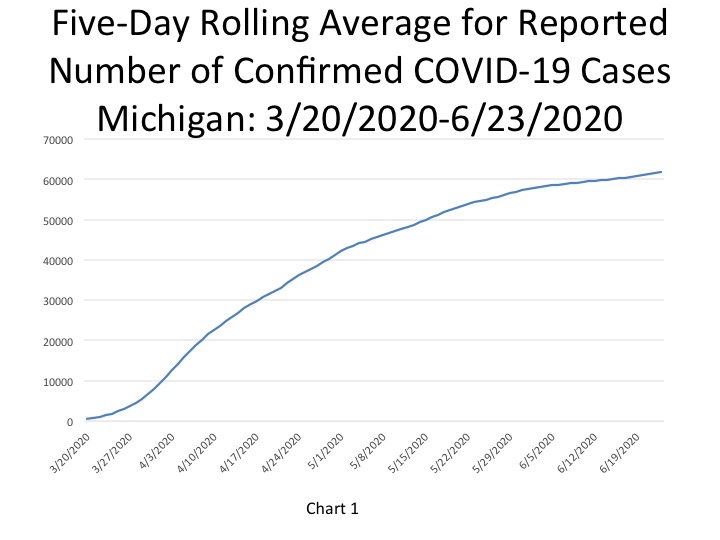
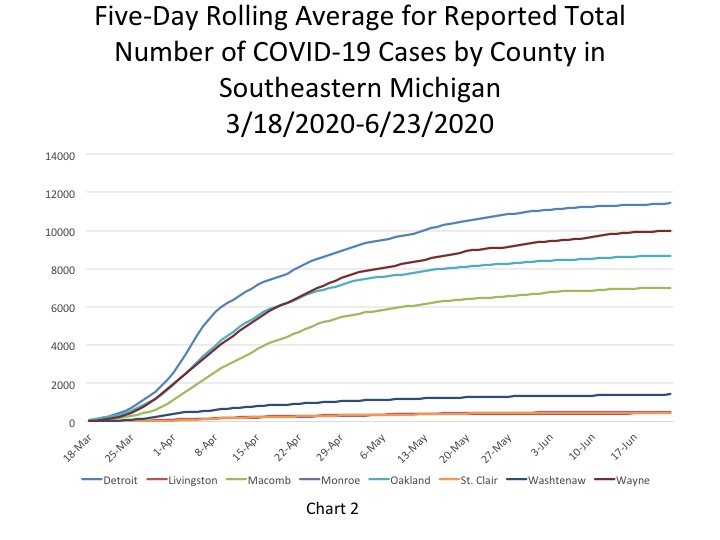
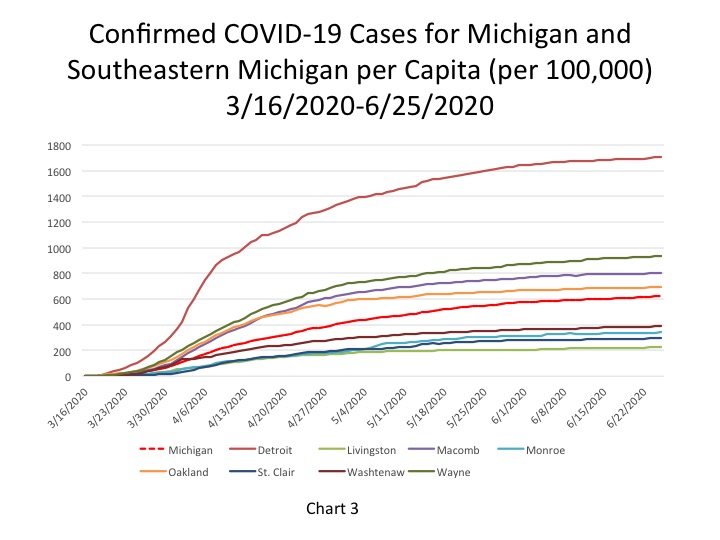
Chart 4 shows that Wayne County reported the highest number of daily cases, according to the five-day rolling average, at 27 on June 23. Detroit reported 23 new daily cases while Macomb and Oakland counties each reported 14. Each one of these five-day rolling average data points are higher than what has been reported in over a week, again showing signs that COVID numbers are increasing at a higher rate now than in recent weeks.
On June 25, the per capita rate for the number of new daily COVID cases per 100,000 people was 4 for the State, which was equivalent to 353 new cases. On June 25, Detroit and Monroe County also had a per capita rate for the number of new daily COVID cases per 100,000 people of 4. For the City of Detroit this per capita rate was equivalent to 24 new cases on June 25. Wayne County had the highest per capita rate for the number of new daily COVID cases per 100,000 people in the region at 5; this was equivalent to 49 new cases. In Southeastern Michigan there were 144 new COVID cases reported on June 25, an increase from the 123 new COVID cases reported the day prior.
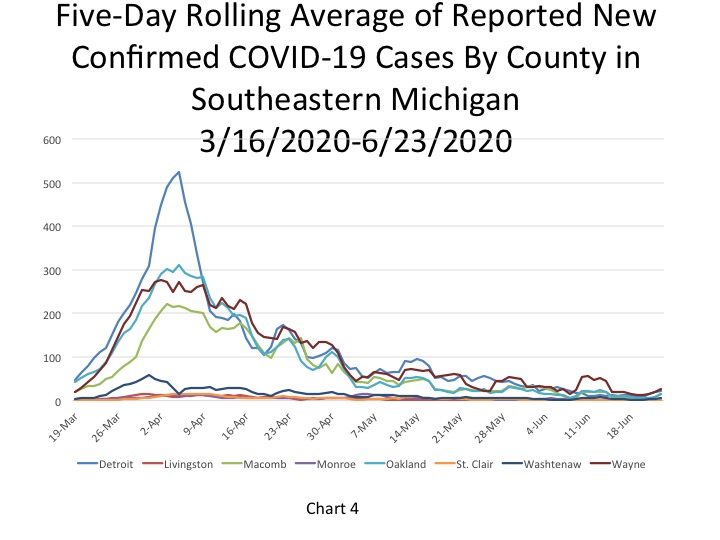
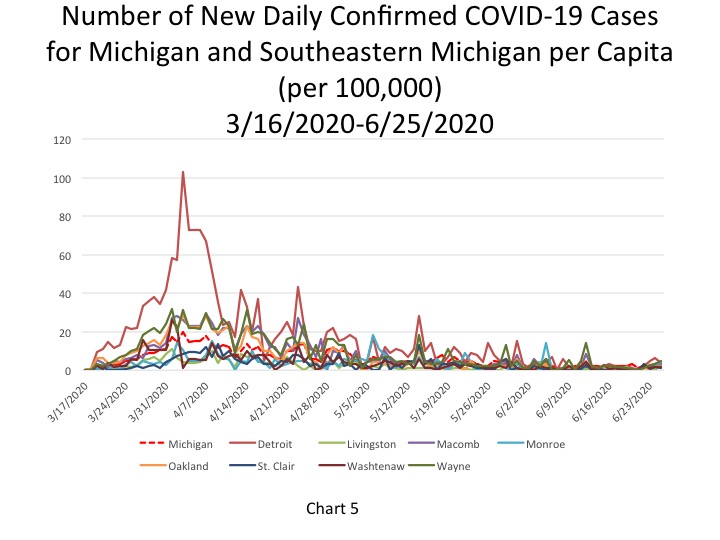
In Chart 6, the five-day rolling average for the number of deaths in Michigan shows how they have leveled off during the month of June, but continue to inch toward a total of 6,000 deaths. On June 23 there were 5,864 deaths (an increase of 9 deaths from the day prior). The actual cumulative COVID-19 deaths on June 25 was 5,887, an increase of 19 deaths from the prior day. Of those deaths that were reported on June 25, 14 were in Southeastern Michigan. So, while new COVID cases numbers are increasing at a higher rate outside of Southeastern Michigan, the region continues to account for majority of the deaths.
Chart 7 (a 5-day rolling average) further reflects how the number of deaths has leveled off in the State and Southeastern Michigan. On June 23 the City of Detroit reported 1,431 deaths, an increase of 2 deaths from the day prior. Wayne County had the second highest total at 1,143 deaths on June 23.
The per capita rates for the number of total COVID deaths in Southeastern Michigan remained the same for each entity, except Detroit, on June 25. Detroit reported 214 total COVID deaths per 100,000 people (a slight increase from a rate of 213 the day prior), which was equivalent to 1,438 deaths. Wayne County reported a per capita rate of 106 (1,145 deaths), Macomb County reported a per capita rate of 99 (863 deaths) and Oakland County reported a per capita rate of 82 (1,043 deaths). Each county in Southeastern Michigan, and the City of Detroit, have experienced no increase to minimal increases in the per capita rates for the number of total COVID deaths for the last several weeks.
The State of Michigan reported a per capita rate for the number of total COVID deaths at 59 per 100,000 people, which was equivalent to 5,887 total deaths.
Chart 9, the five day rolling average of deaths, shows the number of new statewide deaths was reported at 9 on June 23. Furthermore, Chart 10 shows how the number of deaths in Southeastern Michigan continues to decline. Detroit reported 2 new deaths on June 23 and Wayne County reported 1; the other counties in the region reported 0. These numbers are based on 5-day rolling averages.
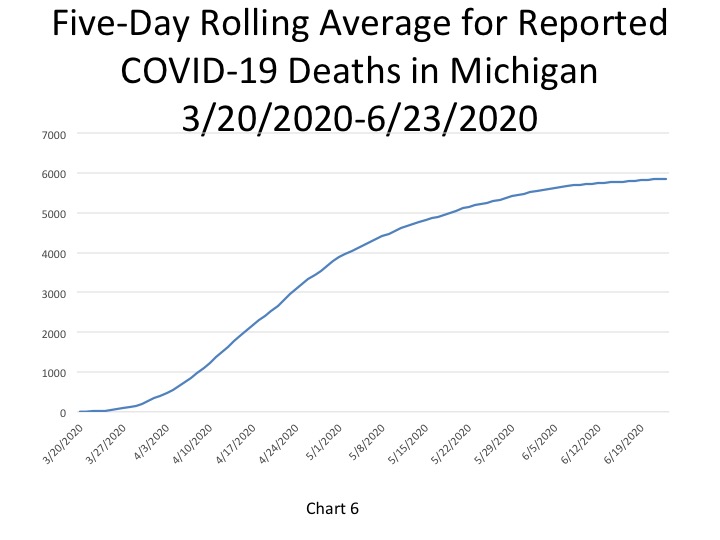
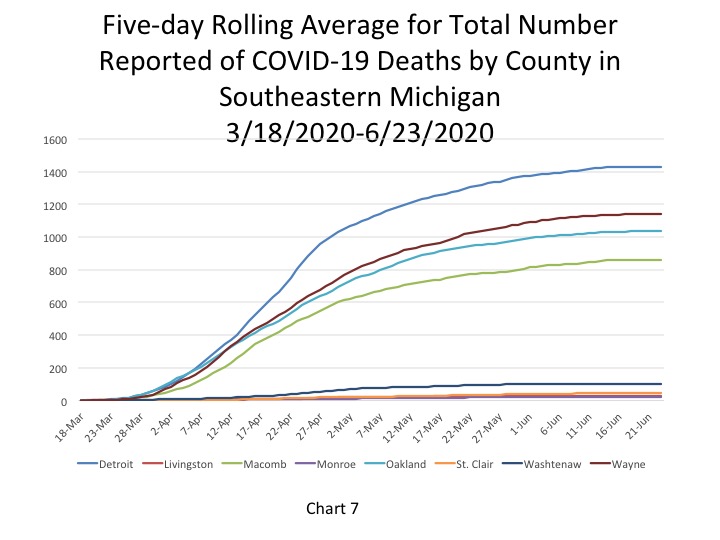
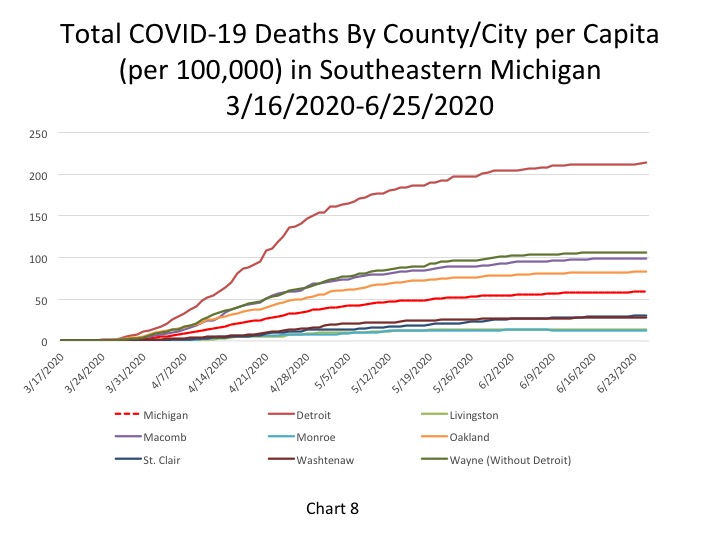
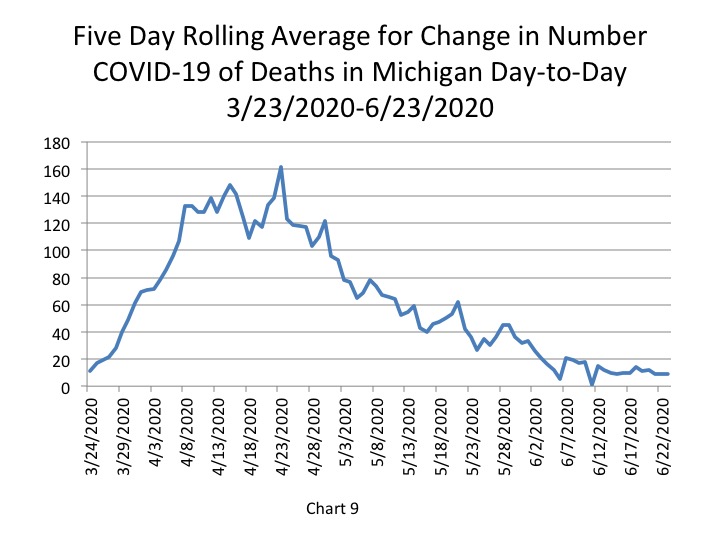
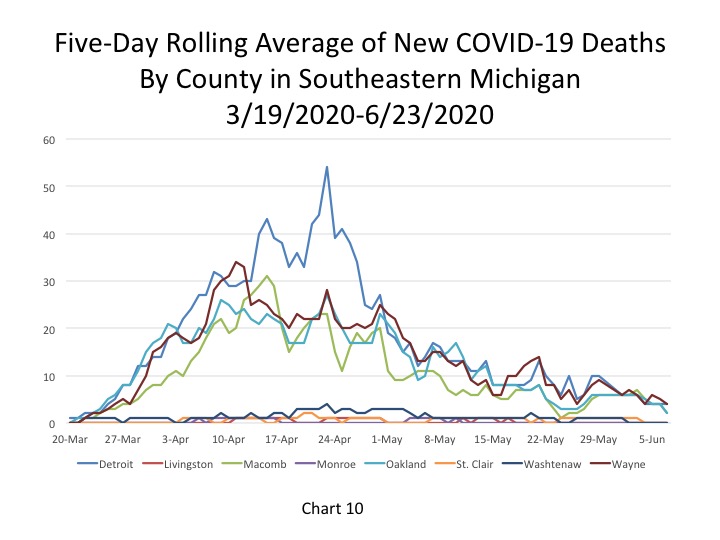
For the State of Michigan, the City of Detroit and Macomb and Oakland counties the fatality rates have remained stable for the last two weeks. Detroit continues to report the highest fatality rate at 12.5 percent while the State’s fatality rate is 9.5 percent. Chart 11 also shows that the fatality rates for Wayne, Monroe and Livingston counties have also been decreasing.
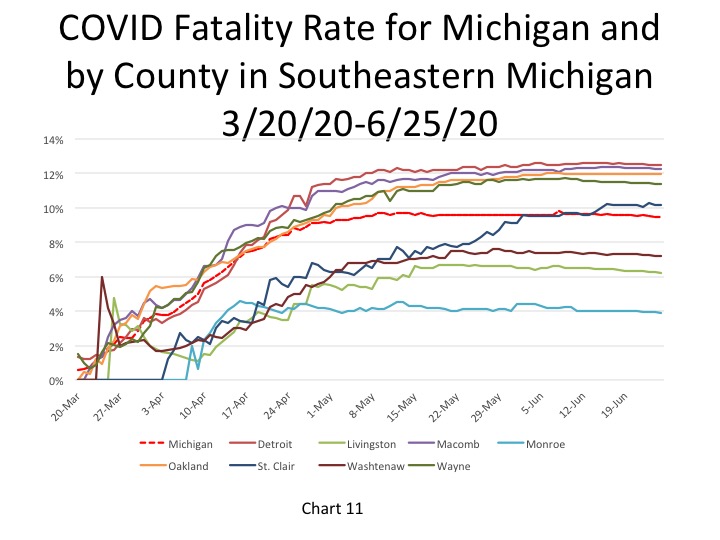
Nationwide, several states are seeing some of the highest new daily COVID cases they have yet experienced. And, while Michigan’s numbers are lower than April, signs are pointing toward an upward trend statewide. This comes as the State is slowly beginning to re-open. However, Gov. Gretchen Whitmer did say Michigan is not ready to enter Stage 5 of the re-opening phase because there are still concerns of the virus spreading at a rapid pace. She has taken this decision as other states experience large daily spikes, and isolated hot spots continue to pop up in Michigan (such as a recent East Lansing incident). Currently, Michigan ranks ninth in the number of confirmed cases and sixth in the number of reported deaths linked to COVID-19.